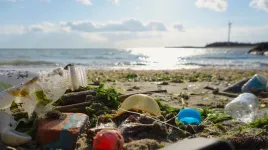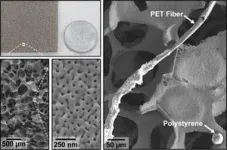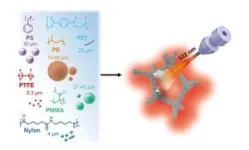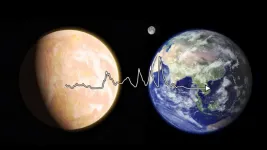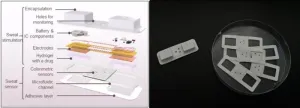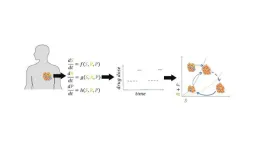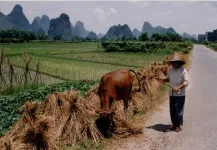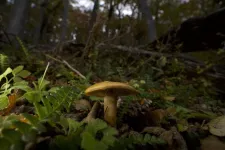(Press-News.org) Optical analysis and machine learning techniques can now readily detect microplastics in marine and freshwater environments using inexpensive porous metal substrates. Details of the method, developed by researchers at Nagoya University with collaborators at the National Institute for Materials Sciences in Japan and others, are published in the journal Nature Communications.
Detecting and identifying microplastics in water samples is essential for environmental monitoring but is challenging due in part to the structural similarity of microplastics with natural organic compounds derived from biofilms, algae, and decaying organic matter. Existing detection methods generally require complex separation techniques that are time-consuming and costly.
“Our new method can simultaneously separate and measure the abundance of six key types of microplastics - polystyrene, polyethylene, polymethylmethacrylate, polytetrafluoroethylene, nylon and polyethylene terephthalate,” says Dr. Olga Guselnikova of the National Institute for Materials Science (NIMS).
The system uses a porous metal foam to capture microplastics from solution and detect them optically using a process called surface-enhanced Raman spectroscopy (SERS). “The SERS data obtained is highly complex,” explains Dr. Joel Henzie of NIMS, “but it contains discernible patterns that can be interpreted using modern machine learning techniques.”
To analyse the data, the team created a neural network computer algorithm called SpecATNet. This algorithm learns how to interpret the patterns in the optical measurements to identify the target microplastics more quickly and with higher accuracy than traditional methods.
“Our procedure holds immense potential for monitoring microplastics in samples obtained directly from the environment, with no pretreatment required, while being unaffected by possible contaminants that could interfere with other methods,” says Professor Yusuke Yamauchi of Nagoya University.
The researchers hope their innovation will greatly assist society in evaluating the significance of microplastic pollution on public health and the health of all organisms in marine and freshwater environments. By creating inexpensive microplastic sensors and open-source algorithms to interpret data, they hope to enable the rapid detection of microplastics, even in resource-limited labs.
Currently, materials required for the new system bring cost savings of 90 to 95% compared to commercially available alternatives. The group plans to drive the cost of these sensors down even further and make the methods simple to replicate without the need for expensive facilities. In addition, the researchers hope to expand the capability of the SpecATNet neural network to detect a broader range of microplastics and even accept different kinds of spectroscopic data in addition to SERS data.
END
Inexpensive microplastic monitoring through porous materials and machine learning
2024-05-28
ELSE PRESS RELEASES FROM THIS DATE:
Mystery of ‘slow’ solar wind unveiled by Solar Orbiter mission
2024-05-28
Scientists have come a step closer to identifying the mysterious origins of the ‘slow’ solar wind, using data collected during the Solar Orbiter spacecraft’s first close journey to the Sun.
Solar wind, which can travel at hundreds of kilometres per second, has fascinated scientists for years, and new research published in Nature Astronomy, is finally shedding light on how it forms.
Solar wind describes the continuous outflow of charged plasma particles from the Sun into space – with wind travelling at over 500km ...
Study suggests ‘biodegradable’ teabags don’t readily deteriorate in the environment and can adversely affect terrestrial species
2024-05-28
Some teabags manufactured using plastic alternatives do not degrade in soil and have the potential to harm terrestrial species, a new study has shown.
The research looked at commonly available teabags made using three different compositions of polylactic acid (PLA), which is derived from sources such as corn starch or sugar cane.
The teabags were buried in soil for seven months, and a range of techniques were then used to assess whether – and to what extent – they had deteriorated.
The results showed that teabags made solely from PLA remained completely intact. However, the ...
Algorithms could help improve judicial decisions
2024-05-28
A new paper in the Quarterly Journal of Economics, published by Oxford University Press, finds that replacing certain judicial decision-making functions with algorithms could improve outcomes for defendants by eliminating some of the systemic biases of judges.
Decision makers make consequential choices based on predictions of unknown outcomes. Judges, in particular, make decisions about whether to grant bail to defendants or how to sentence those convicted. Companies now use machine learning based models increasingly in high-stakes decisions. There are various assumptions about human behavior underlying the deployment of ...
Scientists uncover a multibillion-year epic written into the chemistry of life
2024-05-28
The origin of life on Earth has long been a mystery that has eluded scientists. A key question is how much of the history of life on Earth is lost to time. It is quite common for a single species to "phase out" using a biochemical reaction, and if this happens across enough species, such reactions could effectively be "forgotten" by life on Earth. But if the history of biochemistry is rife with forgotten reactions, would there be any way to tell? This question inspired researchers from the Earth-Life Science Institute (ELSI) at the Tokyo Institute of Technology, and the California Institute of Technology (CalTech) ...
Monitoring diseases through sweat becomes accessible to everyone
2024-05-28
Sweat contains biomarkers that can monitor various health conditions, from diabetes to genetic disorders. Sweat sampling, unlike blood collection, is preferred by users due to its painless nature. However, to obtain sufficient nutrients or hormones from sweat for testing, intense physical activity was previously required to induce sweat. This method posed challenges for individuals with limited mobility.
Dr. Kim Joohee from the Bionics Research Center at the Korea Institute of Science and Technology (KIST, Director Oh Sangrok) and Professor John A. Rogers from Northwestern University jointly announced the development ...
Mathematical model driven evolutionary therapy dosing exploiting cancer cell plasticity
2024-05-28
Cancer poses significant challenges due to the development of resistance and the likelihood of relapse. Resistance may arise from permanent genetic changes in cancer cells or non-genetic alterations in cancer cell behavior induced by treatment. Standard of care in cancer treatments typically involves administering the maximum tolerated dose of a drug to eradicate drug-sensitive cells effectively. However, this approach often fails in the long term because drug-resistant cancer cells can grow more rapidly when all drug-sensitive cancer ...
Biodiversity in the margins: Merging farmlands affects natural pest control
2024-05-28
A new study published in the Journal of Applied Ecology demonstrates how the diversity and abundance of arthropods decrease when hedgerows and field margins covered by wild grass and flowers are removed.
Researchers from the UK, Netherlands and China studied 20 rice fields in China for six years to see how the changing agricultural landscape affects the diversity and abundance of rice pests and their natural enemies, as well as the effect on rice yield.
Traditional Chinese smallholder fields are irregularly shaped and separated by areas of hedgerows, wild grass, and flowers. Using large-scale machinery in these farmlands is difficult, so there is low agricultural ...
1 in 8 pregnant people have a disability, but significant gaps exist in the provision of accessible care
2024-05-28
Toronto, ON, May 28, 2024 – People with disabilities account for 13% of all pregnancies in Ontario, but a new report shows that this population was more likely to experience pregnancy complications such as emergency department visits, hospitalizations, and preterm birth.
Researchers from ICES, the University of Toronto Scarborough, and the Centre for Addiction and Mental Health (CAMH) have released a landmark report detailing findings from one of the largest studies to date on disability and pregnancy.
Funded by the US National Institutes of Health, the Disability and Pregnancy Study used healthcare ...
Statins associated with decreased risk for CVD and death, even in very old adults
2024-05-27
Embargoed for release until 5:00 p.m. ET on Monday 27 May 2024
Annals of Internal Medicine Tip Sheet
@Annalsofim
Below please find summaries of new articles that will be published in the next issue of Annals of Internal Medicine. The summaries are not intended to substitute for the full articles as a source of information. This information is under strict embargo and by taking it into possession, media representatives are committing to the terms of the embargo not only on their own behalf, but also on behalf of the organization they represent.
----------------------------
1. Statins associated with ...
Climate change is moving tree populations away from the soil fungi that sustain them
2024-05-27
As our planet warms, many species are shifting to different locations as their historical habitats become inhospitable. Trees are no exception – many species’ normal ranges are no longer conducive to their health, but their shift to new areas that could better sustain them has been lagging behind those of other plants and animals. Now, scientists show that the reason for this lag might be found belowground. A study published in PNAS on May X, shows that trees, especially those in the far ...
